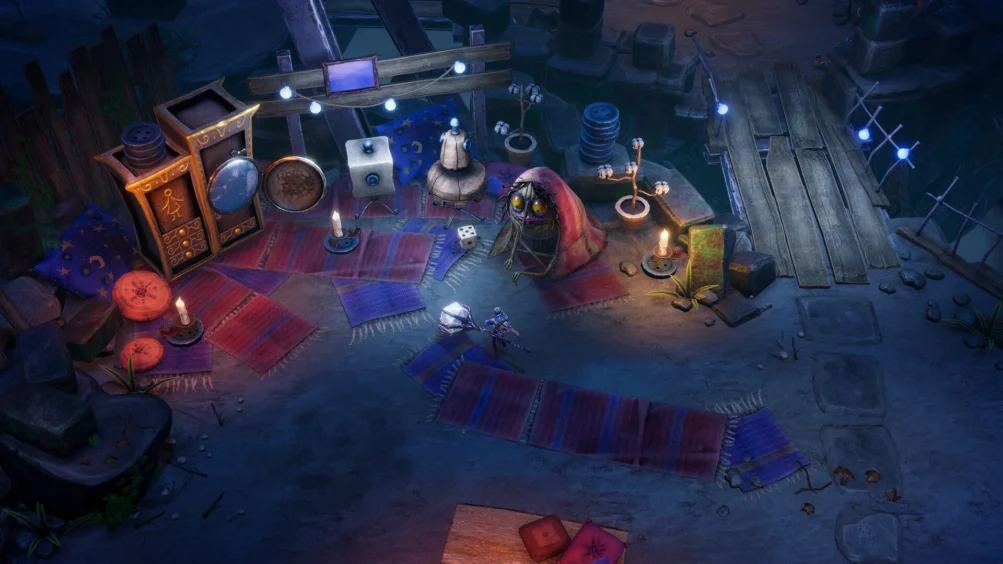Misplaced in Random The Everlasting Die, developed by Stormteller Video games and printed by Thunderful Publishing, marks a daring style shift from the 2021 motion‑journey unique. That is the place gothic fairy‑story appeal meets rolling cube, tactical deck‑constructing, and fast-paced roguelike runs.
The Setting & Story: Queen on a Quest
You play as Queen Aleksandra, as soon as the shadowy ruler of Random, now trapped inside the Black Die—a cursed artifact born of destiny and remorse. To atone and reclaim management, she should battle by means of the shifting rooms of the Black Die, confront Mare the Knight, and try redemption… one strategic run at a time.
The narrative is emotionally grounded and surprisingly mature—exploring management, loss, and the randomness of life. It doesn’t pull punches, however generally leans into metaphor a bit too closely.
Character & Lore Depth
Aleksandra isn’t only a protagonist—she’s a former antagonist looking for redemption. Every biome displays a chapter of her previous, with enemies and managers drawn from her personal historical past of cruelty and management. These encounters aren’t simply battles—they’re reckonings. The sport cleverly makes use of environmental storytelling and NPC dialogue to disclose her regrets, making every run really feel like a step towards emotional closure.
Fight & Gameplay: Technique with a Aspect of Mayhem
Misplaced in Random The Everlasting Die merges real-time motion with turn-based tactical decisions. You’ll be able to’t unleash particular assaults till you gather crystals and roll Fortune. Card assaults and relics convey selection and construct depth to every run.
Weapon combine: sword, hammer, bow, lance—every with cost and improve paths.
Fortune: your sentient die—throw him for ranged injury and retrieve him manually.
Relics: over 100 to combine and match, affecting all the things from builds to die interactions.
Playing cards: 15 talents starting from poison daggers to freezing vortexes.
The tempo is sharper than the unique, with roguelike loops impressed by Hades. Whereas some runs really feel underpowered if luck is unhealthy, pulling off a crucial construct or relic combo is immensely satisfying.

Fight Circulation & Synerg
Early runs really feel chaotic, however as you unlock relics and playing cards, synergy turns into the secret. Poison builds stack injury over time, freeze builds management house, and bounce relics flip Fortune right into a ricocheting menace. The true pleasure comes from discovering combos—like pairing a slow-time relic with a multi-hit card for devastating impact. It’s not nearly luck; it’s about studying learn how to bend randomness to your will.
World & Development: Procedural however Thematic
Every playthrough spans 4 randomly‑generated biomes, every with distinctive environment and challenges. Exploration rewards curiosity: hidden rooms, mini‑video games, NPCs, and upgrades await. Between runs, the Sanctuary enables you to spend cash, degree up Fortune, and customise your construct for subsequent time.
Sanctuary & Development
Between runs, the Sanctuary affords greater than upgrades—it’s a spot to replicate, strategize, and reshape your strategy. You’ll be able to put money into Fortune’s talents, unlock new relic slots, and even tweak card possibilities. It’s right here that the roguelike loop tightens: every dying turns into a blueprint on your subsequent construct, and every improve nudges you nearer to mastery

Visuals & Sound: Darkish Whimsy Refined
Visually, Misplaced in Random The Everlasting Die carries over the unique’s Tim Burton‑meets‑Coraline aesthetic with much more polish. The environments really feel hand‑crafted regardless of the procedural structure, with sturdy lighting, textures, and character design. Audio-wise, a haunting, playful soundtrack and expressive voice performing convey depth—although just a few NPCs can yak on a bit. Nonetheless, the vibe is wealthy and immersive.
Steadiness & Problem: Simply Proper, Practically
In keeping with director Martin Storm, the sport ended up barely simpler than meant—however deliberately so. Issue is tuned so studying curves clean out early runs, ramping steadily with enemy selection and relic complexity.
A full run usually lasts about two hours and rewards persistence over perfection.
The Circulation: Addictive, with Some Repetition
The loop can really feel repetitive—you’ll replay rooms, reroll relics, and repeat builds. However for followers of roguelikes, the randomness is a part of the enchantment. A failed run turns into a lesson, and the subsequent construct would possibly simply really feel unstoppable. Nonetheless, pacing can drag if relic drops don’t favor your technique or if rooms repeat too usually.

Last Verdict
Misplaced in Random The Everlasting Die doesn’t rehash the unique’s slower narrative journey. As a substitute, it embraces randomness, technique, and roguelike replayability with placing fashion and polish. It’s not excellent—some fight runs really feel grindy, and pacing can stutter—however its appeal, depth, and tactical satisfaction make it a worthy evolution.
Should you like cube, builds, gothic fairytales, and roguelike challenges rolled into one fashionable bundle, that is your recreation.
Misplaced In Random The Everlasting Die Trailer
Learn extra superior evaluations >>right here<<.
Recreation code was offered by the Writer.
I reviewed it, after which it was edited by my associate.


